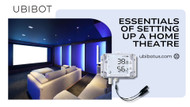Leveraging IoT Temperature and Humidity Sensors for Ambient Lighting Optimization
Posted by UBiBot USA on Jun 20th 2023
In today's interconnected world, the Internet of Things (IoT) has revolutionized the way we interact with our environment. One of the exciting applications of IoT technology is the integration of temperature and humidity sensors to enhance ambient lighting systems. In this blog, we will explore how IoT temperature and humidity sensors contribute to creating a comfortable and energy-efficient lighting experience, specifically focusing on the concept of "Ambien Light."
Understanding IoT Temperature and Humidity Sensors
IoT temperature and humidity sensor are innovative devices that capture and transmit data for optimal lighting conditions. These sensors function by accurately measuring temperature and humidity levels in the surrounding environment. By converting these measurements into electrical signals, they transmit the data to connected systems in real-time. The importance of precise temperature and humidity measurements lies in their ability to influence lighting settings.
With this data, lighting systems can adjust and optimize their performance to create a comfortable and visually appealing ambiance. IoT sensors enable dynamic responses to changes in temperature and humidity, ensuring that lighting remains consistent and suitable for the given conditions.
Enhancing Comfort with Ambient Lighting
Ambient lighting plays a significant role in creating a comfortable environment. It sets the overall mood, improves visibility, and impacts human perception. Temperature and humidity also influence how lighting is perceived. Extreme temperatures or high humidity levels can affect visual comfort and may lead to discomfort. By leveraging IoT sensors, it becomes possible to monitor and regulate ambient conditions in real-time.
These sensors provide data on temperature and humidity, allowing lighting systems to dynamically adjust and optimize their settings. This ensures that the lighting remains comfortable and visually pleasing, contributing to an overall enhanced experience and well-being in the space.
Creating Energy-Efficient Lighting Solutions
By utilizing real-time data captured by these sensors, lighting systems can adjust lighting levels based on environmental conditions. This dynamic adjustment ensures that energy is used optimally without compromising visual comfort. By integrating IoT sensors with adaptive lighting systems, it becomes possible to create lighting environments that adapt to changes in temperature and humidity, providing the right amount of light when and where it is needed. This not only reduces energy consumption but also contributes to sustainable practices and cost savings for businesses and individuals alike.
Introducing Ambien Light: The Perfect Lighting Experience
Ambien Light is a concept that aims to create the perfect lighting experience in various environments. It involves leveraging IoT sensors to achieve personalized and adaptive lighting settings. By utilizing real-time data from temperature and humidity sensors, Ambien Light can dynamically adjust lighting levels and color temperatures to match the desired atmosphere and user preferences.
This customized lighting experience has numerous benefits, including enhancing well-being, improving productivity, and creating visually appealing environments. Whether it's in residential, commercial, or industrial settings, Ambien Light offers a tailored lighting experience that contributes to a more comfortable, productive, and enjoyable space for individuals and enhances the overall ambiance.
Applications of IoT Temperature and Humidity Sensors in Ambient Lighting
In commercial environments, such as offices, retail spaces, and hospitality venues, IoT sensors play a crucial role in optimizing lighting conditions. By monitoring temperature and humidity, lighting systems can adapt and provide appropriate lighting levels, enhancing employee productivity and customer experience.
Industrial applications benefit from IoT sensors by maintaining ideal lighting environments in manufacturing and production facilities. By monitoring temperature and humidity, lighting systems can ensure consistent and suitable lighting conditions for workers, ensuring their safety and optimizing productivity.
Overall, IoT temperature and humidity sensors have wide-ranging applications in ambient lighting, contributing to creating comfortable, productive, and visually appealing environments across residential, commercial, and industrial settings.
Challenges and Considerations in Implementing IoT Sensors for Ambient Lighting
Implementing IoT sensors for ambient lighting comes with certain challenges and considerations that need to be addressed. One of the primary concerns is privacy and security. Data collection and transmission from IoT sensors must be secured to protect sensitive information.
Ensuring the accuracy and reliability of the sensors is crucial for consistent lighting control. Regular calibration and maintenance are necessary to maintain the desired performance levels.
Integrating IoT sensors with existing lighting systems and infrastructure can be a complex task. Compatibility issues, retrofitting requirements, and system interoperability need to be carefully addressed to ensure a seamless integration process.
By addressing these challenges and considerations, the implementation of IoT sensors for ambient lighting can be successful, providing enhanced lighting experiences while ensuring data privacy, accuracy, and seamless integration with existing systems.
Future Trends and Innovations in Ambient Lighting
The future of ambient lighting holds exciting possibilities with advancements in technology. Emerging trends include the development of IoT sensors with improved temperature and humidity monitoring capabilities, allowing for more precise and accurate data collection.
Integration of artificial intelligence (AI) and machine learning algorithms is another promising trend. These technologies enable advanced lighting control, where systems can learn and adapt to user preferences and environmental conditions, providing personalized lighting experiences.
Furthermore, ambient lighting is expected to be a key component of smart home automation. Seamless integration with other IoT devices, such as voice assistants and smart thermostats, will enable synchronized and intuitive control of lighting throughout the home.
With these future trends and innovations, ambient lighting will continue to evolve, offering enhanced comfort, energy efficiency, and personalized experiences in homes and various environments.

